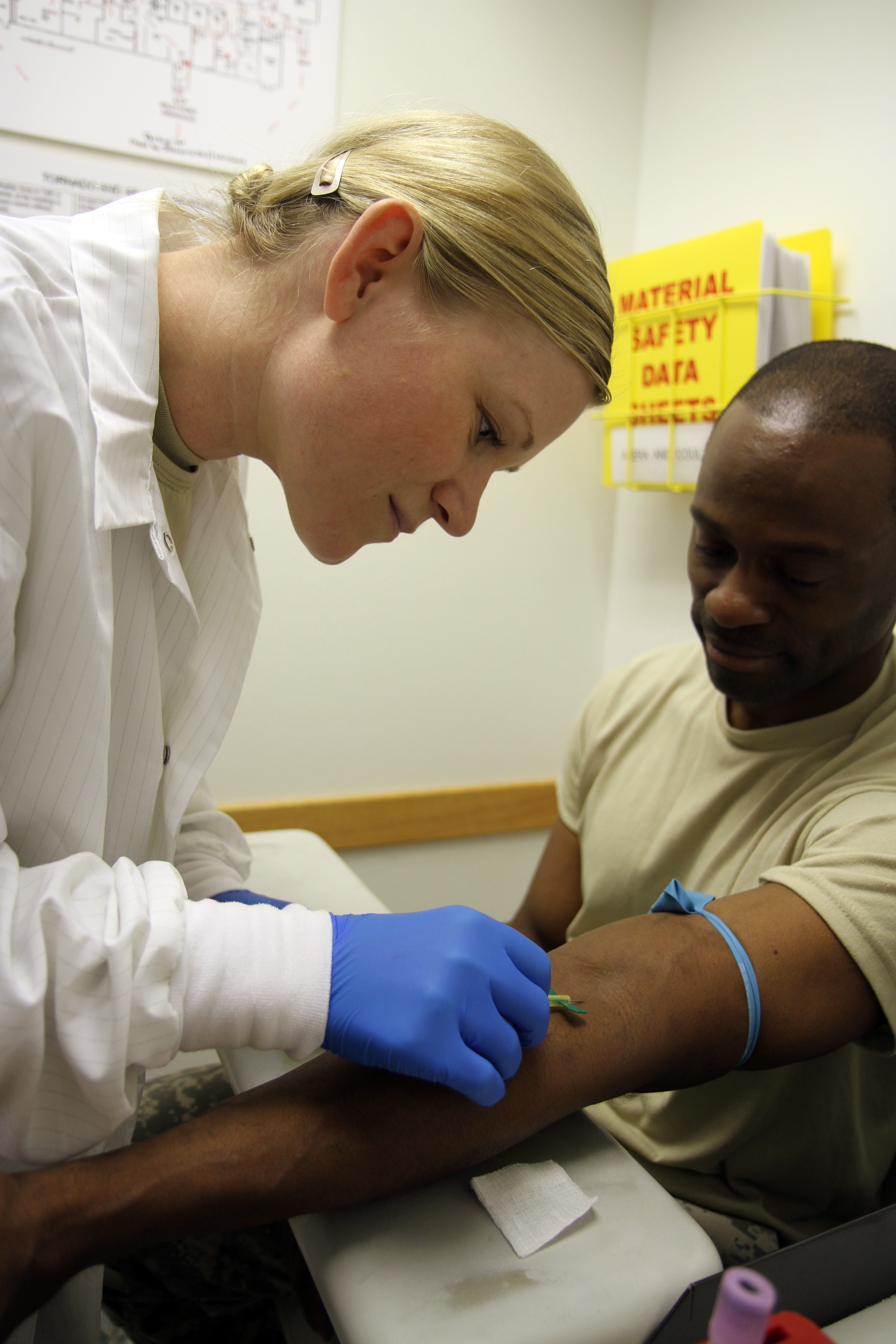Template:The Comprehensive Guide to Physician Office Laboratory Setup and Operation/Primary laboratory testing domains in the POL/Molecular diagnostics
2.6 Molecular diagnostics
The field of molecular diagnostics and its application in the POL continue to be promising. We initially addressed the topic of molecular diagnostics throughout the the prior chapter, but let's discuss it a bit more.
Molecular testing is largely nucleic acid-based testing, which the FDA describes as "tests [that] analyze variations in the sequence, structure, or expression of deoxyribonucleic acid (DNA) and ribonucleic acid (RNA) in order to diagnose disease or medical conditions, infection with an identifiable pathogen, or determine genetic carrier status."[1] The FDA maintains a list of approved nucleic acid-based human genetic, microbial, and companion diagnostic tests, most of which are classified as CLIA moderate or high complexity.[1][2] As such, with the exception of the Abbott ID NOW system and a handful of other test kits (e.g., Mesa Biotech's Accula RSV Test[3]), molecular diagnostic testing in the POL has largely been limited to the previously mentioned 11.9 percent that maintain a CLIA compliance or accreditation certificate.
However, since at least the mid-2010s, many experts in the industry have expected CLIA-waived molecular testing to gradually become more prevalent. Alberto Gutierrez, FDA director of the Office of In Vitro Diagnostics and Radiological Health, emphasized this in early 2015 with the first CLIA-waived approval of the Alere i System (later acquired by Abbott and renamed "ID NOW"), saying "We expect many other simple and accurate tests using nucleic acid-based technology to be developed in the near future."[4] This expectation would largely be met through test devices that have the greatest practical clinical use, according to Ihor Boszko, vice president of business development for molecular diagnostics company Xagenic Inc. In June 2015, Boszko suggested that "widespread adoption of POC molecular diagnostics will be driven by tests that have the greatest clinical utility and that provide demonstrable efficiencies to the healthcare system that are unattainable through traditional central laboratory methods."[5]
While enthusiasm for molecular testing grew in the late 2010s, so too did concerns of how public payers would cover and reimburse such tests. In an April 2015 piece for the American Association for Clinical Chemistry's (AACC's) Clinical Laboratory News, AACC managing editor Bill Malone and Quorum Consulting director of strategic product planning Genevieve Tang highlighted some of the concerns and considerations of reimbursement in the U.S. Tang argued one of the most important ways for manufacturers to have private payers cover their new molecular tests is to tie patient outcomes to clinical decision making. "Securing payer coverage is increasingly going to require clinical utility studies that clearly demonstrate how use of the test improves patient outcomes,"[6] Tang said, elaborating with the following:
Payers look for three levels of evidence when they decide whether or not to cover a test, Tang explained. “The first is analytical validity, which refers to the accuracy, precision, and reproducibility of the test results. The second is clinical validity, which is the correlation of the test results with the clinical outcomes of interest,” Tang said. “Third is clinical utility, which may seem an abstract concept, but essentially refers to how use of the test influences clinical decision-making and/or improving patient outcomes. This third level of evidence is what payers are really looking for.”[6]
By 2020, the Association of Molecular Pathology (AMP) was reiterating the difficulties associated with molecular pathology economics, noting that "[t]he rapid adoption and continuous technological evolution of molecular diagnostics have often strained the development and maintenance of a functional underlying framework of coding, coverage, and reimbursement policies."[7] As AMP and others note, the pace of technological advancement with molecular diagnostics has ran faster than "the issuance of codes, guidelines and payer policies," as well as overall knowledge about coding for DNA- and RNA-based tests.[8] This adds extra complication to the POL seeking to add CLIA-waived (or even moderate complexity) molecular testing. However, momentum towards advancements of molecular diagnostics tools and information systems—particularly as an outgrowth of the COVID-19 pandemic—is still strong[9], and perhaps more CLIA-waived and moderate complexity molecular tests[10] and more efficient reimbursement pathways[7] will continue to emerge for the POL.
- ↑ 1.0 1.1 "Nucleic Acid Based Tests". U.S. Food and Drug Administration. 19 April 2022. https://www.fda.gov/medical-devices/in-vitro-diagnostics/nucleic-acid-based-tests. Retrieved 13 May 2022.
- ↑ "Nucleic Acid Based Tests". U.S. Food and Drug Administration. 19 April 2022. https://www.fda.gov/medical-devices/in-vitro-diagnostics/nucleic-acid-based-tests. Retrieved 13 May 2022.
- ↑ "Mesa Biotech Accula (Accula RSV Test)". CLIA Database. U.S. Food and Drug Administration. 16 May 2022. https://www.accessdata.fda.gov/scripts/cdrh/cfdocs/cfCLIA/Detail.cfm?ID=39776. Retrieved 17 May 2022.
- ↑ Seiffert, Don (12 January 2015). "FDA waiver of Alere's flu test poses threat to market leader Cepheid". Boston Business Journal. American City Business Journals. https://www.bizjournals.com/boston/blog/bioflash/2015/01/fda-waiver-of-aleres-flu-test-poses-threat-to.html. Retrieved 13 May 2022.
- ↑ Boszko, Ihor (June 2015). "CLIA-waived molecular diagnostic tests are poised to transform clinical Microbiology". Medical Laboratory Observer. NP Communications, LLC. https://www.mlo-online.com/home/article/13008264/cliawaived-molecular-diagnostic-tests-are-poised-to-transform-clinical-microbiology. Retrieved 13 May 2022.
- ↑ 6.0 6.1 Malone, Bill (1 April 2015). "The Reimbursement Outlook for Molecular Diagnostics". Clinical Laboratory News. American Association for Clinical Chemistry. https://www.aacc.org/cln/articles/2015/april/the-reimbursement-outlook-for-molecular-diagnostics. Retrieved 13 May 2022.
- ↑ 7.0 7.1 Sireci, Anthony N.; Patel, Jay L.; Joseph, Loren; Hiemenz, Matthew C.; Rosca, Oana C.; Caughron, Samuel K.; Thibault-Sennett, Sarah A.; Burke, Tara L. et al. (1 August 2020). "Molecular Pathology Economics 101: An Overview of Molecular Diagnostics Coding, Coverage, and Reimbursement" (in en). The Journal of Molecular Diagnostics 22 (8): 975–993. doi:10.1016/j.jmoldx.2020.05.008. PMC PMC7267794. PMID 32504675. https://linkinghub.elsevier.com/retrieve/pii/S1525157820303536.
- ↑ "Molecular Testing – Why Is Reimbursement Lacking?". Medlearn Media. 31 July 2020. https://www.medlearnmedia.com/insights/laboratory-insights/molecular-testing-why-is-reimbursement-lacking/. Retrieved 17 May 2022.
- ↑ Pritzker, Kenneth (3 June 2021). "Impact of the COVID-19 pandemic on Molecular Diagnostics" (in en). Expert Review of Molecular Diagnostics 21 (6): 519–521. doi:10.1080/14737159.2021.1923481. ISSN 1473-7159. https://www.tandfonline.com/doi/full/10.1080/14737159.2021.1923481.
- ↑ Thill, M. (October 2020). "Selling Moderate Complexity". Repertoire. https://repertoiremag.com/selling-moderate-complexity.html. Retrieved 17 April 2022.










